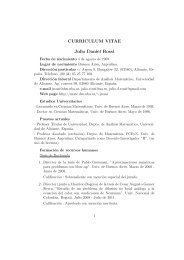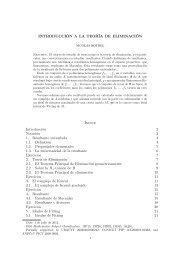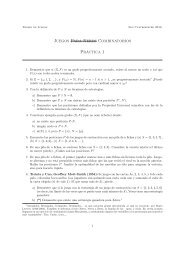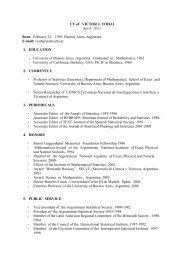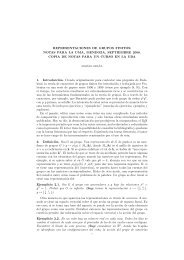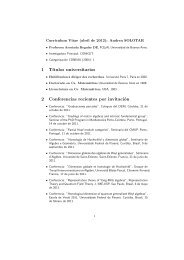You also want an ePaper? Increase the reach of your titles
YUMPU automatically turns print PDFs into web optimized ePapers that Google loves.
2.8<br />
2.6<br />
2.4<br />
2.2<br />
2<br />
1.8<br />
1.6<br />
1.4<br />
1.2<br />
x=e t<br />
Interpolación polinomial, h=0.25<br />
x 1 ,…,x 4 con h=0.25<br />
Interpolación polinomial, h=0.125<br />
x 1 ,…,x 8 con, h=0.125<br />
1. MÉTODOS DE UN PASO 171<br />
1<br />
0 0.1 0.2 0.3 0.4 0.5 0.6 0.7 0.8 0.9 1<br />
Figura 8.1. Método de Euler, x ′ = x; x(0) = 1; con pasos h = 0,25 y h = 0,125.<br />
<br />
de la que sabemos que lím 1 +<br />
n→∞<br />
1<br />
n<br />
n<br />
<br />
xn = 1 + 1<br />
n ,<br />
n<br />
= e.<br />
La Tabla 8.1 muestra los valores que se obtienen si se usa el método ed Euler con paso h = 0,25<br />
y paso h = 0,125. Estos datos pueden apreciarse en la Figura 8.1.<br />
t e t h = 0,25 h = 0,125<br />
0.125 1.1331 1.125000<br />
0.250 1.2840 1.250000 1.265625<br />
0.375 1.4549 1.423828<br />
0.500 1.6487 1.562500 1.601807<br />
0.625 1.8682 1.802032<br />
0.750 2.1170 1.953125 2.027207<br />
0.875 2.3989 2.280697<br />
1.000 2.7183 2.441406 2.565784<br />
Cuadro 8.1. Método de Euler, x ′ = x; x(0) = 1; con paso h = 0,25 y h = 0,125<br />
El método general de un paso tiene la forma<br />
xi+1 = xi + hΦ(ti, xi, h). (8.4)







